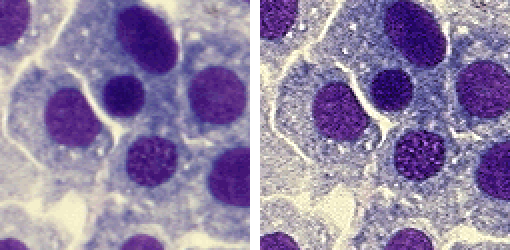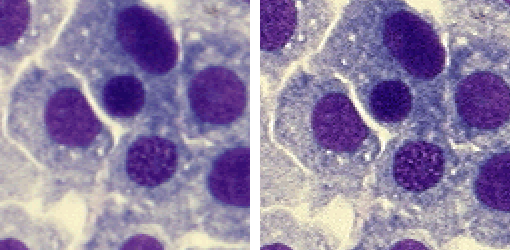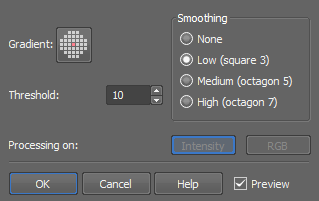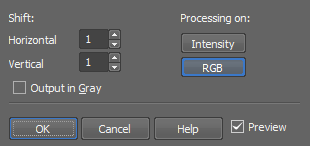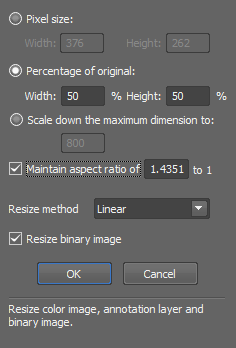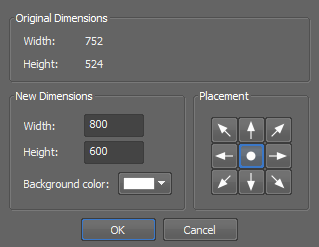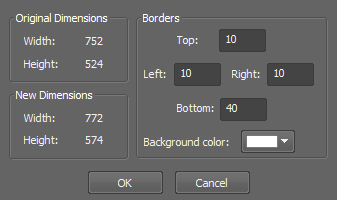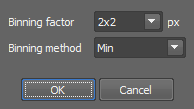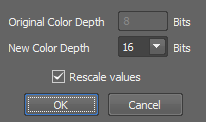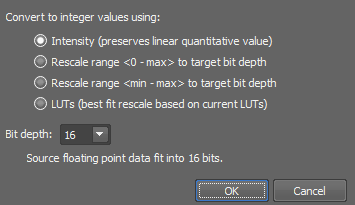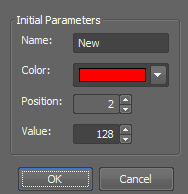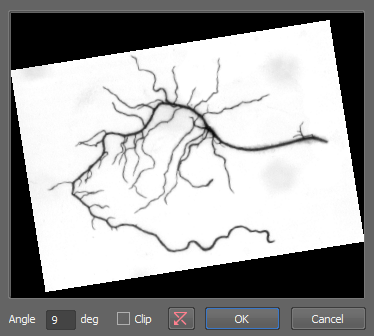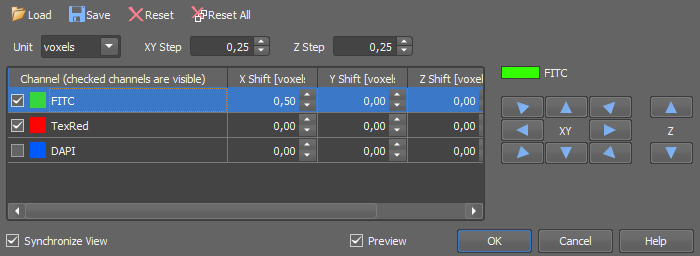Turn the Background ROI ON, or set any existing ROI as background (right-click a ROI and select Use as Background ROI).
Place the ROI so that it would define the background you would like to subtract.
Invoke the Subtract Background command. The average value of background is subtracted from each channel.
None
Low
Medium
High
Select the shifting units - voxels (in 3D), pixels (in 2D) or micrometers.
Define XY(Z) step size for the arrow and spin buttons.
Select a check box next to one channel to set it as reference. This channel will be always visible.
Note
Make sure the Synchronize View option is turned on.
Click a table row to give focus to the channel you want to shift (the row gets highlighted). Use the arrow buttons to shift the channel as necessary.
It is a good idea to open the ND image in another view (such as volume view) to check whether the shift between channels has been corrected.
Click to apply the shifts on all frames.

Increases contrast of the image. It changes intensities of the current image. Hue and saturation are not affected. Intensities are rescaled according to the selected method.
Options
Sets the Range so that the limits correspond to the minimum and maximum intensities found in the image.
The parameter for the Gamma Correction method. It ranges from 0.05 to 5.00. Set Gamma < 1 to get more information in dark areas or set Gamma > 1 to enhance bright parts of the image.
Set the low/high contrast intensities. Pixels with intensity greater than the high value set will be changed to a pure white, whereas pixels with intensity smaller than the low value set will be changed to pure black (zero). The range itself will be stretched to fit the available intensity range.
Closes the dialog window and applies the contrast settings.
Closes the dialog window without applying the contrast settings.
Opens this help page.
Turns the preview on/off.
See Image processing for description of other settings.
Methods
These transformations stretch the intensity interval defined by the range to the full intensity range using the selected curve. All values outside the range are set to pure black and pure white.
Equalization transformation leads to uniform intensity distribution in the specified interval <Low, High>.
Gamma correction maps the intensity interval <Low, High> according to exponential equation with the gamma parameter.
Balances and adjusts red, green and blue components of the current RGB image. One or two circular probes appear in the image. Move the probes to specify the white point and - optionally - the black point in the image.
Shows Red, Green and Blue values for the white probe.
Shows Red, Green and Blue values for the black probe.
Shows the black level probe.
If checked, the values of all color components are recalculated to fit the full intensity range <0,255>.
Coefficient for gamma correction.
Note
Probe assignment is determined dynamically. If you move the red probe (white balance) over an image area which is darker then the area under the green probe (black balance), the probes swap automatically, so the text color in the window swaps as well to indicate the change.
See Image processing for description of other settings.
Transforms color image independently for each RGB component.
Type of image transformation.
Adds Red resp. Green resp. Blue value to red resp. green resp. blue component of each pixel.
Subtracts Red resp. Green resp. Blue value from red resp. green resp. blue component of each pixel.
Assigns minimum of red resp. green resp. blue component and Red resp. Green resp. Blue value to relevant component of each pixel.
Assigns maximum of red resp. green resp. blue component and Red resp. Green resp. Blue value to relevant component of each pixel.
Assigns Red resp. Green resp. Blue to red resp. green resp. blue component of each pixel.
Multiplies red resp. green resp. blue component of each pixel by Red resp. Green resp. Blue value.
Divides red resp. green resp. blue component of each pixel by Red resp. Green resp. Blue value.
Value used for red component.
Value used for green component.
Value used for blue component.
Initializes the previous value for selected color.
Apply the operation to the current image and close the window.
See Image processing for description of other settings.
Transforms intensities by arithmetic operations.
Type of the image transformation.
Adds Intensity to each pixel.
Subtracts Intensity from each pixel.
Selects minimum between each pixel intensity and Intensity.
Selects maximum between each pixel intensity and Intensity.
Sets the same Intensity to each pixel.
Multiplies each pixel by Intensity.
Divides each pixel by Intensity.
The value used for the arithmetic operation.
Value added to each pixel after the operation. It can be negative.
Displays the preview image.
Apply the operation to the current image and close the window.
See Image processing for description of other settings.

Changes saturation of an RGB image.
Expresses the degree of saturation enhancement. Positive values result in lively colors. Negative values de-saturate the image.
See Image processing for description of other settings.
Changes the color tone of an RGB image while maintaining its brightness and saturation.
The hue is measured in degrees on the color wheel <0, 360>.
Apply the operation to the current image and close the window.
Note
This transformation is used for color image enhancement. Note, for instance, that positive hue shift turns blue color towards red.
See Image processing for description of other settings.

Transforms a color image into its complementary color image.
See Image processing for description of other settings.
This command subtracts background defined by the background probe from the whole image.
Subtracting background
Choose how the background ROI is calculated.
Define custom value. The offset value adds a constant to the subtracted intensity, which is calculated as the average intensity of the background ROI, prior to subtraction in order to preserve image details.
See Image processing for description of other settings.
This command subtracts pixel values of the reference image from the current image. The reference image is created by the Reference > Current Image -> Reference menu command.
You can further modify pixel intensities of the corrected image by defining offset (positive or negative).
Subtracts a value from each channel separately.
The value to be subtracted from each pixel of the selected channel. On RGB images, the value is subtracted from all channels automatically.
See Image processing for description of other settings.

This command performs smoothing on the color image.
The Smooth Color Image dialog box appears:
Click the button to change the structuring element used for this operation. See Matrix.
Number of iterations.
 Reset
Reset Sets the dialog default values.
Process each RGB channel separately or perform the processing on the intensity channel? See Image processing.
Select this option to preview the effect of the operation on the current image.
This function filters small irregularities in images.
See Image processing for description of other settings.

This function sharpens the image.
See Image processing for description of other settings.
This function slightly sharpens the image.
See Image processing for description of other settings.

Detects edges by morphological transformations on color images.
The DetectValleys dialog box appears:
Click the button to change the structuring element used for this operation. See Matrix.
Number of iterations.
 Reset
Reset Sets the dialog default values.
Apply the operation to the current image and close the window.
Process each RGB channel separately or perform the processing on the intensity channel? See Image processing.
Note
The Detect Valleys command enhances small dark objects by “Top Hat” morphologic transformation. The size of the selected objects is determined by level of the transformation, which depends on Matrix type and on Number of steps. This command enables the specific segmentation of small objects to the exclusion of larger objects and also can help you in the case of non-homogeneous background.
The Detect Valleys (Top Hat) dialog box appears.
Click the button to change the structuring element used for this operation. See Matrix.
Number of iterations.
 Reset
Reset Sets the dialog default values.
Apply the operation to the current image and close the window.
Process each RGB channel separately or perform the processing on the intensity channel? See Image processing.
Note
Detect Peaks command enhances small light objects by “Top Hat” morphologic transformation. The size of objects selected is determined by the size of the used structuring element, which depends both on Matrix and Number parameters. This command enables the specific segmentation of small objects to the exclusion of larger objects and also can help you in the case of non-homogeneous background.
This command enhances the edges in the image.
See Image processing for description of other settings.
Detects edges by morphological transformations of color images.
The Morphologic Gradient dialog box appears:
Click the button to change the structuring element used for this operation. See Matrix.
Number of iterations.
 Reset
Reset Sets the dialog default values.
Process each RGB channel separately or perform the processing on the intensity channel? See Image processing.
Note
Morphologic gradient is the difference between dilated and eroded images. It enhances edges.
Performs morphological opening on current color image. Morphological opening is erosion followed by the same number of dilations. The transformation removes small light objects. If the structuring element dimension has an odd value, there are two enhanced pixels in structuring element depicting centers: one for erosion and the other for dilation.
The Open Color Image dialog box appears.
Click the button to change the structuring element used for this operation. See Matrix.
Number of iterations.
 Reset
Reset Sets the dialog default values.
See Image processing for description of other settings.
Performs morphological closing on the current color image.
The Close on Color Image dialog box appears.
Click the button to change the structuring element used for this operation. See Matrix.
Number of iterations.
 Reset
Reset Sets the dialog default values.
See Image processing for description of other settings.
Morphological closing is a dilation followed by the same number of erosions. Small dark areas are removed by this transformation. If the structuring element dimension has an odd value, there are two enhanced pixels in structuring element depicting centers: one for erosion and the other for dilation.
Enhances edges and smooths homogeneous areas in color image. The Delineate dialog box appears:
Size of matrix for gradient detection.
Size of matrix for smoothing.
Threshold value for gradient.
Apply the operation to the current image and close the window.
Process each RGB channel separately or perform the processing on the intensity channel? See Image processing.
Note
In the resulting image, edges are enhanced and smooth areas are more homogeneous.
Creates a pseudo 3-D image. The Relief dialog box appears:
Sets the shift (in pixels) along X axis.
Sets the shift (in pixels) along Y axis.
If checked, the result of the transformation is a gray image. This option is only applicable to RGB images.
Process each RGB channel separately or perform the processing on the intensity channel? See Image processing.
Note
Superimposition of the original and the shifted image results in a pseudo 3-D image.

Cuts off everything outside the selected area. Selecting this command invokes the crop cursor. Click the primary mouse button and drag to define the cropping area. Adjust the area you want to crop using the red rectangle. Move the white squares on the rectangle edges to adjust its size and move the whole rectangle using the primary mouse button to set its position.
Another way to set the crop is to use the dialog window in which you can specify the Left and Top corners of the rectangle, its Width, Height and the units used (pixels, µm, mm). Once you finish defining the cropping rectangle, confirm it by clicking .
The  Draw Rectangle... button hides the dialog window and lets you draw the cropping rectangle manually. Remember Last Settings remembers the crop data which can be reused in future image cropping. If the image being cropped with the remembered data is smaller than the previously cropped one, it may be reduced and moved automatically.
Draw Rectangle... button hides the dialog window and lets you draw the cropping rectangle manually. Remember Last Settings remembers the crop data which can be reused in future image cropping. If the image being cropped with the remembered data is smaller than the previously cropped one, it may be reduced and moved automatically.
Splits an image into separate tiles. Please see Splitting Large Images for more information.
Using this command it is possible to adjust image dimensions. You can enter the new size as an exact value in pixels or in percents of the current image.
If this option is chosen, you need to enter new dimensions of the image in pixels.
In case this option is checked, you can enter the size of new image in percents of the current image.
Scales down the image. The longer side of the image is rescaled to the defined number of pixels while the aspect ratio is kept. Shorter side of the image is calculated automatically.
If this option is active, you can enter only one dimension of new image and the other is filled automatically to keep selected aspect ratio. Aspect ratio is computed and prefilled according to your current image dimensions.
You can choose from three different resize algorithms. Try which one works best for your application.
Every NIS-Elements image consist of three (or more) layers (Color, Binary, Annotation...). The Color and annotation layers are linked together, but binary image behaves independently. Checking this option causes simultaneous resizing of both Color and Binary layers.
See Also
Image > Convert > Change Color Depth
This command sets the dimensions of current image. Selecting this command displays the following window:
The upper part of window is informational and shows current image dimensions. You can set new dimensions using the Width and Height edit-boxes. The image will not be resized, but cropped (in case of new dimensions are smaller than the old ones) or placed in the image, surrounded by borders in background color (in the case of new dimensions are grater than original image). You can define the placement of an old image in the new image using the arrow button tool.
This command adds color borders to current image. Selecting this command, the following dialog box appears:
The left side of window is dedicated to information about image size. The original dimensions are displayed here.
You see the dimensions with borders added.
Four-edit boxes on the right serve for entering the border thickness in pixels. Each edit-box stands for one image side. The color of image frame is possible to define using color picker called Background color.
Opens the Image Binning dialog window enabling to bin the current image based on the binning factor and binning method.
Binning factor of 3x3 will reduce the area of 9 pixels into a single pixel in the resulting image based on the selected method.
The resulting pixel value will be calculated as maximum, minimum, mean or sum. Sum No Noise - this method brightens the image but does not amplify noise like the Sum method does.
Transforms current color image into gray image.
Note
The resulting intensities are defined for every pixel as an average of red, green and blue component values.
Transforms the current gray image into a color image.
Note
The resulting RGB image consist of three components with identical values. The image looks still grey.
This command changes the image (image) type of the current RGB image to Multichannel. The Custom channel is appended.
This command changes the color depth of the current image. You can increase or decrease the depth to 8, 10, 12 or 16 bits.
Displays the color depth of the current image.
Sets a new color depth of your image. You can choose from 8, 10, 12, 16 bit.
If checked the pixel values are mapped to the new range. E.g. when you convert an 8bit image to 16bit and you do not select to rescale values, it results in a completely black image. If the check box was selected, the 8bit 255 value would become 65535 in 16bit etc.
See Also
Image > Size > Resize
Use this command to convert a floating point image to a new standard image. Define which method is used to convert the currently opened floating point image to integer values. Select the bit depth of the new image. Recommended bit depth is displayed below the pull down menu.
Converts the image to integer values with minimum loss of quantitative information.
Stretches the interval “0 to image maximimum” to fit the target bit depth.
Stretches the interval “image minimum to image maximimum” to fit the target bit depth.
Stretches the interval “LUTs black slider to LUTs white slider” to fit the target bit depth. See LUTs - Non-destructive Image Enhancement.
Select target bit depth of the resulting image.
Transforms an RGB image to one of its RGB or HSI components. On multichannel images, the HSI color space is not available.
Select the type of component to be extracted from the pull down menu.
A channel from the RGB color representation.
A component from the HSI color representation. Not available
Note
In the resulting gray image all RGB components are identical and the image is stored in the same way as a “usual” color image.
Adds a new channel to the current image. The following dialog appears:
Enter a name of the new channel.
Select its color from the color palette.
Set its position within the existing channel.
Set the intensity of all pixels of the new channel.
Performs free image rotation. The Rotation dialog box appears:
Defines the angle of the rotation. The rotated image is previewed in the dialog box. The angle is oriented with value ranges from 360 to -360 degree.
Crops the rotated image
 Reset
Reset Sets the rotation angle back to 0 degree.
Performs a rotation via line. Drawing the line you specify only the angle of rotation. The center of the rotation will be in the center of the image. Defined line in the image is rotated to become horizontal using the sharp angle. Rotated image is computed from the source using 4-neighbourhood.
Performs rotation via line. Line in the image is rotated to become horizontal. Drawing the line you specify the center and the angle of rotation. Defined line in the image is rotated to become horizontal using the sharp angle. Rotated image is computed from the source using 4-neighbourhood.
Performs rotation via line. Line in the image is rotated to become vertical. Drawing the line you specify the center and the angle of rotation. Defined line in the image is rotated to become vertical using the sharp angle. Rotated image is computed from the source using 4-neighbourhood.
Enables you to select a rectangular shaped part of an image and adjust its final orientation. The rest of the image will be cut off.
Place, resize and rotate the red rectangle. When you confirm the action by right click, the command will crop the image and rotate the selected area, so that the red arrow will point upwards.
This command moves the current image or a selected component by one pixel in the defined direction. The pixels that overflow the image borders appear on its opposite side.
When using this command via the key shortcut (Ctrl+Shift+Arrow) on a single component, all components are displayed together until the Ctrl+Shift keys are released.
This command moves the current image or a selected component by one pixel in the defined direction. The pixels that overflow the image borders appear on its opposite side.
When using this command via the key shortcut (Ctrl+Shift+Arrow) on a single component, all components are displayed together until the Ctrl+Shift keys are released.
This command moves the current image or a selected component by one pixel in the defined direction. The pixels that overflow the image borders appear on its opposite side.
When using this command via the key shortcut (Ctrl+Shift+Arrow) on a single component, all components are displayed together until the Ctrl+Shift keys are released.
This command moves the current image or a selected component by one pixel in the defined direction. The pixels that overflow the image borders appear on its opposite side.
When using this command via the key shortcut (Ctrl+Shift+Arrow) on a single component, all components are displayed together until the Ctrl+Shift keys are released.

This function clears the color layer of a image. All pixel intensities are set to zero.
Clears current annotation layer and sets color of all pixels to transparent.
Opens the Align Channels dialog window enabling to manually shift each channel in the X, Y or Z direction.
Example procedure
Dialog Window Options
 Load
Load Load previously saved shift settings from the list.
 Save
Save Use this button to save shift settings for later use.
 Reset
Reset Clears shift settings of the selected (highlighted) channel.
 Reset All
Reset All Clears shift settings for all channels.
Voxels (3D), pixels (2D), micrometers for calibrated images.
Step used by the arrow buttons. Uses the selected units.
If turned on, only channels selected in the table (checked or highlighted) are displayed. Deselect the option to control the display by channel tabs in the image window.













